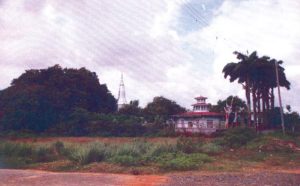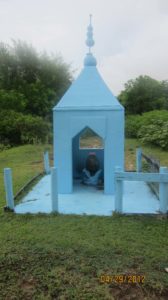Our East Indian ancestors came to British Guiana in 1838, bringing with them their culture, customs and religions. Consequently, our ancestors built mandirs and mosques to fulfil congregational worship.
Located in Ankerville, Corentyne, Berbice, deep in the canfields, is an ancient mandir (only the top is visible). The Ankerville residents explained that this mandir was built by the first batch of East Indians who came to Guyana. One villager recalled her grandparents told her the British took care of the mandir, cleaning the surroundings and lime-washing the lingam (representation of Lord Shiva), which was housed in the mandir. Legend has it that when parsad is offered at the mandir, an alligator, with a gold ‘galihaar’ (necklace), comes out and eats the offering.

Bath Estate, West Berbice, boasts another longstanding mandir. This mandir is said to be over 100 years old and was built by our East Indian ancestors, who also lived on the plantation. It housed logies, schools, hospitals and the masters’ living quarters. The lingam, which is in the mandir, was said to be the size of an egg when the mandir was first built. Today, it has increased in size. Villagers have recognised the value of this mandir and have maintained it throughout the years. Additional works were done at the mandir and a shed was built.
Another age-old mandir, which dates back to indentureship times, is located in Bath backdam. This mandir is very small and houses a lingam. Some villagers offer their prayers at the mandir when they are passing daily to go about their work.
Around 1920, a group of Hindus living in Versailles approached the Versailles Sugar Estate management for a plot of land to build a temple. Versailles Plantation had bought the Malgre Tout Plantation, which was established in the 1800s, and operated it as a sugar estate well into the 1900s. However, by 1920, the factory was in ruins, so the request was granted and a wooden structure with a mud floor was built on the abandoned Malgre Tout Plantation. At the same time, a tall conical shaped concrete structure called a Shivala (temple of Lord Shiva) was constructed from the bricks of the abandoned Malgre Tout Sugar Estate. It was plastered with cement, painted in white and a stone lingam was placed nearby, surrounded by a jasmine hedge where devotees threw ‘dhar’ early in the morning to Lord Shiva. The main temple was painted in a dark maroon colour, while the inside was whitewashed with lime given by the Versailles Estate management.

The Versailles Shivala was one of three such structures built in the colony – the other two were located on the East Coast of Demerara and West Coast of Berbice – and were all designed by the same architect who hailed from Lucknow, India. However, the chief builder supervising the construction was a holy man from Varanasi (Benares), in India, fondly called ‘Banana Sadhu’. The name was given since he brought bananas from the local growers as far as Canal No. 1 and rewarded every person with one banana for each brick brought to the construction site. When the bananas ran out, legend has it, he carefully collected the bricks, recorded the names of those who brought them and ensured that the person received their allotted share of bananas.
Several sacred trees to the Hindus were planted at the same mandir: the papal (peepal) tree, bael tree, neem tree, several types of mango trees, kowa (jack fruit), jack nut (katahar) and bread fruit.
The first official priest, at the ‘matya’, was Pandit Loknauth from Lucknow, India. He arrived to the colony in the early 1900s and was assigned to Plantation Versailles.
Years have passed, but the places of worship built by our ancestors still remain as sanctuaries for many and as a testimony to their faith in the ‘supreme’ (God) during their years of hardship. (Excerpts from story by Deomattie Seeram) (Guyana Times Sunday Magazine)



